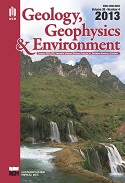Sorption of saturated and unsaturated hydrocarbons on selected coal sample from the Pniówek mine
Main Article Content
Keywords
sorption, coal, saturated and unsaturated hydrocarbons
Abstract
Type, amount and composition of gases which form in rocks and coals during a metamorphism process depend on a number of factors in particular genetic type of original matter, way and conditions of its gathering, temperature, pressure and geological time. Sorption tests were done by the volumetric method, with the use of adsorption micro-burettes. Amajor advantage of the measurement set-up is that the surplus amounts of adsorbate can be used in experiments, which is of particular importance when handling sorbents with heterogeneous structure, such as hard coals. Sorbates used in the test program were the vapours of hexane, hex-1-ene, heptane, hept-1-ene, octane and benzene. Measurement results seem to corroborate the hypothesis that sorption of polar substance vapours is chiefly a surface process. Polarity of hard coals, mostly associated with the presence of reactive oxygen groups (nitrogen and sulphuric groups), largely affects the sorption of polar substances and in a most characteristic manner controls the sorption of apolar ones. In the case of the latter, sorption is induced by the action of the dispersive interaction force between the coal surface and the sorbate’s polar molecules. The pattern of sorption isotherms indicates that the presence of dual bond affects the sorbent-sorbate interactions and hence the sorption capacity of investigated coals.
Downloads
References
Chen Z., Liu J., Elsworth D., Connell L.D. & Pan Z., 2010. Impact of CO2 injection and differential deformation on CO2 injectivity under in-situ stress conditions. International Journal of Coal Geology, 81, 97-108.
Clarkson C.R. & Bustin R.M., 1999. The effect of pore structure and gas pressure upon the transport properties of coal: a laboratory and modelling study: 1. Isotherms and pore volume distributions. Fuel, 78, 1333-1344.
Huang Z.H., Kang F., Zheng Y.P., Yang J.B. & Liang K.M., 2002. Adsorption of trace polar methy-ethyl-ketone and non-polar benzene vapors on viscose rayon-based activated carbon fibers. Carbon, 40, 8, 1363-1367.
Kotarba M., 2001. Composition and origin of coalbed gases in the Upper Silesian and Lublin basins, Poland. Organic Geochemistry, 32, 163-180.
Krzyżanowski A. & Żyła M., 2007. Characteristics of water, methanol and benzene vapours sorption properties of selected metamorphic types of hard coal. Gospodarka Surowcami Mineralnymi - Mineral Resources Management, 23, 4, 139-147.
Labus K., Tarkowski R. & Wdowin M, 2010. Assessment of CO2 sequestration capacity based on hydrogeochemical model of water-rock-gas interactions in the potential storage site within the Bełchatów area (Poland). Gospodarka Surowcami Mineralnymi - Mineral Resources Management, 26, 2, 71-84.
Mirasol J.R., Bedia J., Cordero T. & Rodriguez J.J., 2005. Influence of watervapor on the adsorption of VOCs on lignin-based activated carbons. Separation Science and Technology, 40, 3113-3135.
Nodzeński A., Hołda S. & Orzechowska-Zięba A., 2003. Adsorbate-adsorbate interactions in a hard coal - heptane, heptene-1 system. Annals of the Polish Chemical Society, 2, 1140-1143.
Orzechowska-Zięba A. & Nodzeński A., 2008. Chłonność sorpcyjna węgla kamiennego względem węglowodorów C6-C8. Gospodarka Surowcami Mineralnymi - Mineral Resources Management, 24, 3/3, 245-254.
Prusty B.K., 2007. Sorption of methane and CO2 for enhanced coalbed methane recovery and carbon dioxide sequestration. Journal of Natural Gas Chemistry, 17, 29-38.
Saha S., Sharma B.K., Kumar S., Sahu G., Badhe Y.P, Tambe S.S. & Kulkami B.D., 2007. Density measurements of coal samples by different probe gases and their interrelation. Fuel, 86, 1594-1600.
Shi J.Q. & Durucan S., 2003. A bidisperse pore diffusion model for methane displacement desorption in coal by CO2 injection. Fuel, 82, 1219-1229.
Sobczyk J., 2011. The influence of sorption processes on gas stresses leading to the coal and gas outburst in the laboratory conditions. Fuel, 90, 1018-1023.
Vuthaluru H.B., Brookeb R.J., Zhanga D.K. & Yana H.M, 2003. Effects of moisture and coal blending on Hardgrove Grindability Index of Western Australian coal. Fuel Processing Technology, 81, 1, 67-76.
Walker P.L., Verma S.K., Rivera-Ultrilla J. & Davis A., 1988. Densities, Porosities and surface areas of coal maurals as measured by their interaction with gases. Vapours and Liquids. Fuel, 67, 1615-621.
Youssef A.M., 1974. Moisture sorption in relation to some characteristics of coal. Carbon, 12, 4, 433-438.
Żyła M. & Kreiner K., 2006. Binarny charakter powierzchni węgla kamiennego. Górnictwo i Geoinżynieria, 30, 2, 19-34.
Żyła M., Kreiner K. & Bodek E., 1991. The problem of the chemical nature of hard coals surface and consideration gives to their sorptive properties. Archives of Mining Sciences, 36, 3, 263-274.


